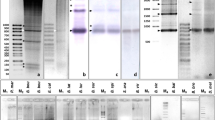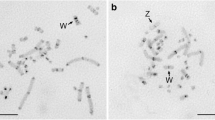Abstract
The chromosomes of the primitive South American teleost fishHoplias malabaricus have been analyzed by classical cytogenetic (C-, AgNOR-, Hoechst 33258-, and Q-banding) techniques. A highly repetitive DNA family has been cloned and sequenced. It is a tandemly repeated sequence of about 355 bp, yielding an overall base pair composition of 67% AT with long runs of >50% As and 70% Ts. Analysis of sequence variation has allowed the further categorization ofHoplias satellite DNA into two evolutionarily related subfamilies A and B, distinguishable by characteristic insertions and deletions within this 355-bp monomer. Subfamily A satellite is found (in diverged form) at the centromeres of mostH. malabaricus chromosomes. Sequence variants are clustered on specific chromosomal subsets. Subfamily B satellite is highly specific for the paracentromeric heterochromatin on one particular chromosome pair by fluorescencein situ hybridization. These results indicate that theHoplias satellite DNA family has evolved in a concerted manner predominantly via recombination events involving homologous, rather than non-homologous chromosome regions. The clones isolated here may be useful for the molecular, genetic, and cytological analysis of the genusHoplias.
Similar content being viewed by others
References
Baltimore D (1981) Gene conversion: some implications for immunoglobulin genes.Cell 24: 592–594.
Bertollo LAC, Takahashi CS, Filho OM (1983) Multiple sex chromosomes in the genusHoplias (Pisces: Erythrinidae).Cytologia 48: 1–12.
Blin N, Stafford DW (1976) A general method for isolation of high molecular weight DNA from eukaryotes.Nucleic Acids Res 3: 2303–2308.
Caspersson T, Zech L, Johannson C, Modest EJ (1970) Identification of human chromosomes by DNA-binding fluorescent agents.Chromosoma 30: 215–227.
Datta U, Dutta P, Mandal K (1988) Cloning and characterization of a highly repetitive fish nucleotide sequence.Gene 62: 331–336.
Denovan EM, Wright JM (1990) A satellite DNA family from pollock (Pollachius virens).Gene 87: 279–283.
Dergam JA, Bertollo LAC (1990) Karyotypic diversification inHoplias malabaricus (Osteichthyes, Erythrinidae) of the São Francisco and Alto Paraná basins, Brazil.Rev Brasil Genet 13: 755–766.
Ekker M, Fritz A, Westerfield M (1992) Identification of two families of satellite-like repetitive DNA sequences from the zebrafish (Brachydanio rerio).Genomics 13: 1169–1173.
Fanning TG (1987) Origin and evolution of a major feline satellite DNA.J Mol Biol 197: 627–634.
Gold JR, Amemiya CT, Ellison JR (1986) Chromosomal heterochromatin in North American cyprinid fishes.Cytologia 51: 557–566.
Goodpasture C, Bloom SE (1975) Visualization of nucleolus organizer regions in mammalian chromosomes using silver staining.Chromosoma 53: 37–50.
Haaf T, Schmid M (1984) An early stage of ZW/ZZ sex chromosome differentiation inPoecilia shenops var. melanistica (Poeciliidae, Cyprinodontiformes).Chromosoma 89: 37–41.
Haaf T, Schmid M (1991) Chromosome topology in mammalian interphase nuclei.Exp Cell Res 192: 325–332.
Haaf T, Warburton PE, Willard HF (1992) Integration of human α-satellite DNA into simian chromosomes: centromere protein binding and disruption of normal chromosome segregation.Cell 70: 681–696.
Hamilton MJ, Honeycutt RL, Basker RJ (1990) Intragenomic movement, sequence amplification and concerted evolution in satellite DNA in harvest mice,Reithrodontomys: evidence fromin situ hybridization.Chromosoma 99: 321–329.
Hamilton MJ, Hong G, Wichman HA (1992) Intragenomic movement and concerted evolution of satellite DNA inPeromyscus: evidence fromin situ hybridization.Cytogenet Cell Genet 60: 40–44.
Jala SM, Clark RW, Hsu TC, Pathak S (1974) Cytological differentiation of constitutive heterochromatin.Chromosoma 48: 391–403.
Lohe AR, Brutlag DL (1986) Multiplicity of satellite DNA sequences inDrosophila melanogaster.Proc Natl Acad Sci USA 83: 696–700.
Machado CR, Gar'ofalo MA, Roselino JE, Kettelhut IC, Migliorini RH (1989) Effect of fasting on glucose turnover in a carnivorous fish (Hoplias sp.).Am J Physiol 256R: 612–615.
Miklos GLG (1985) Localized highly repetitive DNA sequences in vertebrate and invertebrate genomes. In: MacIntyre RJ, ed.Molecular Evolutionary Genetics. New York: Plenum Press, pp. 241–321.
Moyer SP, Ma DP, Thomas TL, Gold JR (1988) Characterization of a highly repeated satellite DNA from the cyprinid fishNotropis lutrensis.Comp Biochem Physiol 91B: 639–646.
Ohta T, Dover G (1983) Population genetics of multigene families that are dispersed onto two or more chromosomes.Proc Natl Acad Sci USA 80: 4079–4083.
Pearson WR, Lipman DJ (1988) Improved tools for biological sequence comparison.Proc Natl Acad Sci USA 85: 2444–2448.
Plohl M, Borstnik B, Lucijanic-Justic V, Ugarkovic D (1992) Evidence for random distribution of sequence variants inTenebrio molitor satellite DNA.Genet Res 60: 7–13.
Riggs A, Fyhn HJ, Fyhn UEH, Noble RW (1979) Studies of the functional properties of the hemoglobins ofHoplias malabaricus andHoplerythrinus unitaeniatus.Comp Biochem Physiol 62A: 189–193.
Schimke RT (1984) Gene amplification in cultured animals cells.Cell 37: 705–713.
Singer MF (1982) Highly repeated sequences in mammalian genomes.Int Rev Cytol 76: 67–112.
Smith GP (1976) Evolution of repeated DNA sequences by unequal crossing over.Science 191: 528–535.
Sumner AT (1972) A simple technique for demonstrating centromeric heterochromatin.Exp Cell Res 75: 304–306.
Warburton PE, Willard HF (1990) Genomic analysis of sequence variation in tandemly repeated DNA. Evidence for localized homogeneous sequence domains within arrays of α-satellite DNA.J Mol Biol 216: 3–16.
Wichman HA, Payne CT, Ryder OA, Hamilton MJ, Maltbie M, Baker RJ (1991) Genomic distribution of heterochromatic sequences in equids: implications to rapid chromosomal evolution.J Hered 82: 369–377.
Willard HF (1990) Centromeres of mammalian chromosomes.Trends Genet 6: 410–416.
Willard HF (1991) Evolution of alpha satellite.Curr Opin Genet Dev 1: 509–514.
Willard HF, Waye JS (1987) Hierarchical order in chromosomespecific human alpha satellite DNA.Trends Genet 3: 192–198.
Wright JM (1989) Nucleotide sequence, genomic organization and evolution of a major repetitive DNA family in tilapia (Oreochromis mossambicus/hornorum).Nucleic Acids Res 17: 5071–5079.
Author information
Authors and Affiliations
Rights and permissions
About this article
Cite this article
Haff, T., Schmid, M., Steinlein, C. et al. Organization and molecular cytogenetics of a satellite DNA family fromHoplias malabaricus (Pisces, Erythrinidae). Chromosome Res 1, 77–86 (1993). https://doi.org/10.1007/BF00710610
Received:
Revised:
Accepted:
Issue Date:
DOI: https://doi.org/10.1007/BF00710610




